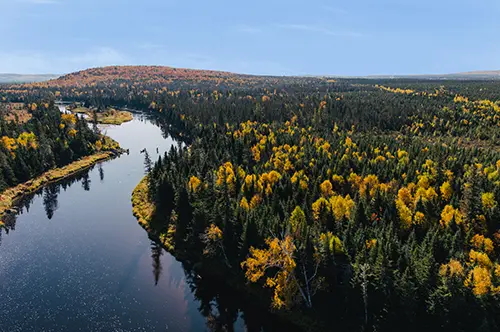What is a working forest?
We call an actively managed forest a working forest. The working forest is at the heart of our approach to sustainability. It is a continuous cycle of harvest and renewal, balancing environmental, social and economic benefits while enabling a growing wood supply for the future.
The working forest is poised to meet the growing need for renewable forest products. It supports diverse species and habitats and enables conservation and resiliency to climate change. It also bolsters communities through population growth, tax revenue and recreational opportunities.
Discover how the working forest works for you.
The working forest works for climate change and resiliency.
Our Forest Supply Chain is independently verified to be carbon neutral, as are our tissue products.
In the face of a warming climate, the working forest helps to mitigate impacts by removing and storing carbon, both in trees and in long-lived forest products. Its diversity of species means the working forest can adapt to climate change, while responsible forest management and silviculture practices create forest health and resiliency.
The working forest has built-in resiliency to pests and forest fires. We plant trees that are less susceptible to eastern spruce budworm. Furthermore, trees in managed forests are more spaced out due to thinning and have less total fuel on the landscape due to the continuous cycle of harvest and renewal, making them less vulnerable to wildfire spread. We maintain our own aircraft, airstrips and wildland firefighting equipment, which, coupled with our monitoring, detection and aggressive early fire suppression system, allows us to respond to keep fires small.

The working forest works for diversity and wildlife.
Working forests are diverse by their very nature. They support a variety of tree species, age classes, patch sizes and forest structures. The continuous cycle of harvest and renewal ensures there’s a mix of younger, middle and mature aged trees that in turn support a diversity of wildlife species.
Across the working forest and conservation land, there is a diversity of forest conditions connected through streams, lakes and wetlands. These provide a variety of habitat types that support a diversity of plant and animal species.
Working forest lands provide important wintering grounds and feeding areas for whitetail deer, while the moose population in New Brunswick is thriving within a responsible working forest model, with harvest levels up by over 1,700 per cent since 1960. Research shows that working forests support abundant habitat for songbirds, with more species diversity on our freehold land compared to other less intensively managed adjacent land. At the landscape level, the working forest compliments other songbird habitat in the conservation forest to increase overall songbird diversity in the region.
The working forest works for communities and customers.
As New Brunswick’s top economic contributor, the forestry sector represents $2.8 billion in provincial exports and 23,000 jobs. It also drives growth through tax base, local spending and private sector investments.
The working forest supports communities in areas like education, community events and recreation. It bolsters population growth through recruiting immigrants to work across our operations and supporting them as they settle.
And there is room to grow. The world is transitioning from single-use plastics to renewable products like paper packaging and grocery bags. The working forest is well-positioned to make a positive impact and supply these demands. And amid a growing need for more housing, the working forest plays a role in increasing the housing inventory by providing low carbon alternatives for building materials.
Source: JD Irving













